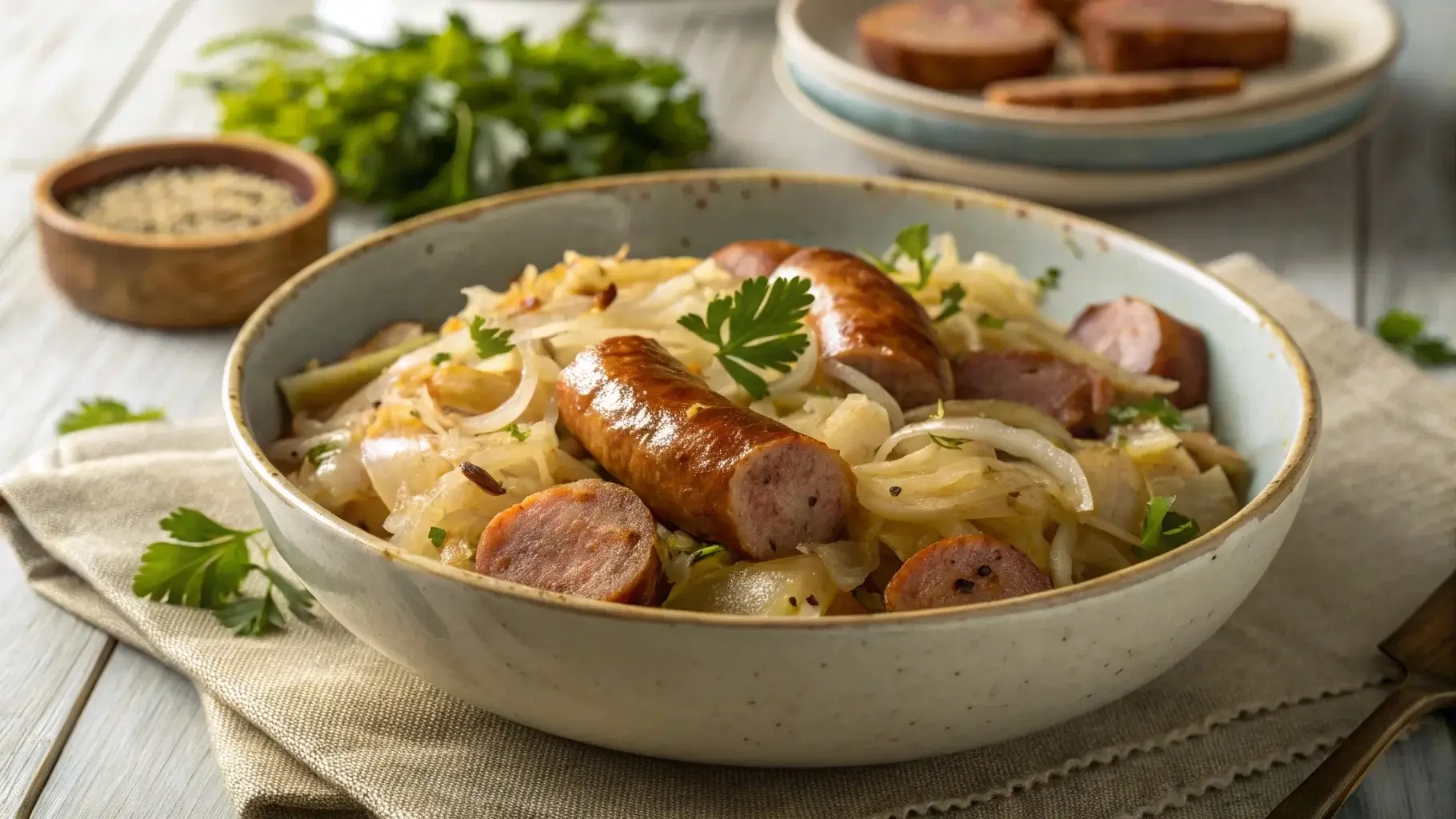When it comes to simple yet hearty meals, cabbage and sausage always comes out on top. This classic combo isn’t just tasty—it’s budget-friendly, easy to prepare, and incredibly versatile. Whether you’re looking for a quick weeknight dinner or a slow-cooked masterpiece, this dish has something for everyone. With influences from European, Southern, and even Asian cuisines, it’s no wonder this meal has earned its place in kitchens worldwide.
This guide will explore everything you need to know, from selecting the best sausages and preparing cabbage to exploring delicious recipe variations, one-pan meals, and health benefits. By the end, you’ll have all the tips and tricks to create the perfect version of this comforting meal.
I still remember the first time Momo and I made this dish together. It was one of those chilly evenings when you crave something warm and filling. We had half a head of cabbage in the fridge and a pack of kielbasa I’d forgotten about. With Momo chopping the cabbage (somewhat messily) and me browning the sausage, we worked as a team—laughing, tasting, and making a bit of a mess. The result? A surprisingly flavorful, satisfying meal that we couldn’t get enough of. Now, it’s our go-to dish whenever we need comfort food.
Let’s dive into what makes cabbage and sausage such a winning combination.
Table of Contents
Why Cabbage and Sausage Is a Beloved Comfort Dish
At its core, cabbage and sausage is about simplicity and flavor. The mild, earthy taste of cabbage blends beautifully with the smoky, savory richness of sausage. Together, they create a dish that’s satisfying without being complicated.
Throughout Europe, especially in Germany and Poland, this combination is a staple in traditional dishes like braised cabbage with bratwurst or kielbasa. In the Southern U.S., it’s often paired with Cajun spices and served alongside cornbread. Regardless of the version you try, the foundation remains the same—a hearty meal that warms you from the inside out.
The dish’s appeal lies in its versatility. You can make it spicy or mild, use smoked sausage or lean chicken sausage, and add vegetables like potatoes, carrots, or bell peppers to bulk it up. Plus, it’s easy to cook in one pan, making cleanup a breeze.
As we go through this guide, you’ll discover variations, nutritional benefits, and tips for perfecting your cabbage and sausage dish every time. (Next, let’s look at the key ingredients that make this meal so special.)
Key Ingredients for Cabbage and Sausage Dishes
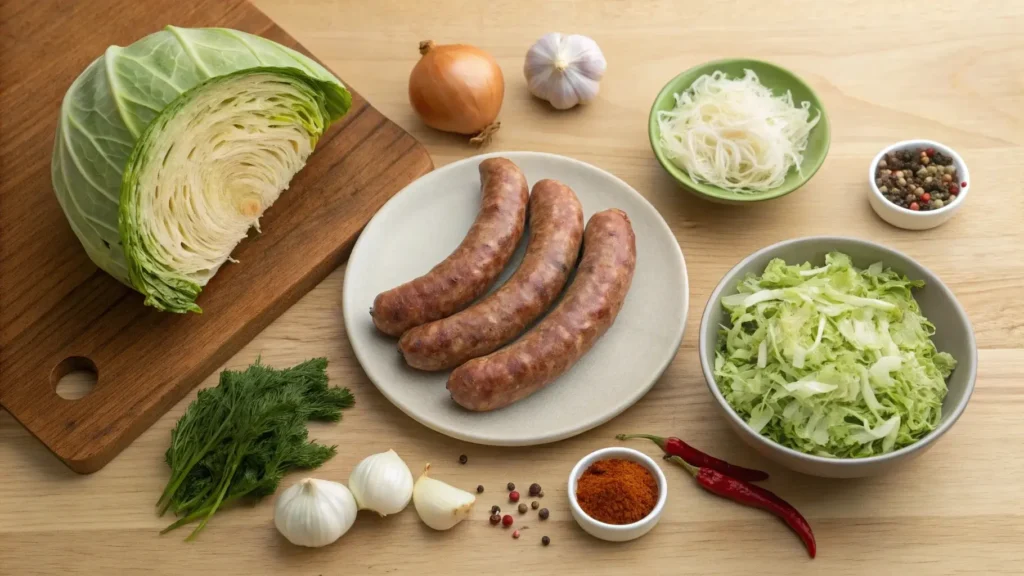
The Perfect Sausage for Cabbage and Sausage
Choosing the right sausage is the first step to creating a flavorful cabbage and sausage dish. Smoked sausage, kielbasa, Andouille, and Italian sausage all work wonderfully, depending on your taste preference. For a smoky and rich flavor, kielbasa is a popular choice, while Andouille brings a Cajun kick. If you’re aiming for a milder version, opt for chicken or turkey sausage to lighten the dish.
The Role of Cabbage
Cabbage is the heart of this dish, offering a soft yet slightly crunchy texture when cooked. Green cabbage is the most common choice, but you can also try Savoy or Napa cabbage for a sweeter and more tender result. Red cabbage is another option that adds color and a slightly tangy flavor. When slicing the cabbage, aim for thin, even strips to ensure quick and even cooking.
Supporting Ingredients to Elevate Flavor
Adding onions, garlic, and bell peppers enhances the aroma and depth of flavor. For heartier variations, consider including diced potatoes or carrots. Seasonings like paprika, thyme, caraway seeds, or bay leaves add layers of flavor. A splash of vinegar or lemon juice at the end helps brighten the dish and balance the richness of the sausage.
Tip: Don’t forget to deglaze the pan with broth, white wine, or even apple cider for a richer, more complex taste.
Classic Cabbage and Sausage Recipe
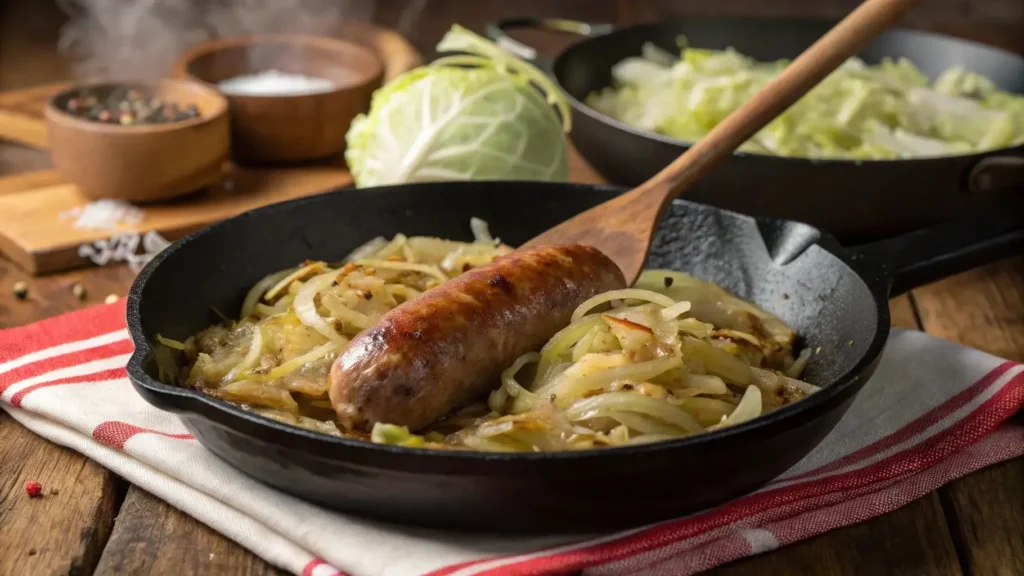
Step 1: Preparing the Ingredients
- Start by slicing the sausage into bite-sized rounds or chunks, depending on how you prefer the texture.
- Thinly slice the cabbage and onions, mince the garlic, and dice any additional vegetables you plan to use.
Step 2: Cooking the Sausage
- Heat a large skillet over medium heat and add a drizzle of olive oil or butter.
- Add the sausage and cook until browned on both sides, about 5-7 minutes. Once done, transfer the sausage to a plate, leaving any rendered fat in the pan for cooking the vegetables.
Step 3: Sautéing the Cabbage and Vegetables
- In the same pan, add the onions and garlic, cooking them until soft and fragrant.
- Add the cabbage gradually, stirring as it wilts. If you’re using potatoes or carrots, add them before the cabbage to give them time to soften. Season with salt, pepper, paprika, or any other spices you enjoy.
Step 4: Deglazing and Bringing It All Together
- Deglaze the pan by pouring in a splash of broth or white wine to scrape up the flavorful bits stuck to the bottom of the pan.
- Return the sausage to the pan and mix everything well. Cover the skillet and let it cook on low heat for about 10-15 minutes, allowing the flavors to meld.
Step 5: Finishing Touches and Serving
- Taste the dish and adjust the seasoning if needed. For a fresh burst of flavor, squeeze in some lemon juice or add a splash of vinegar.
- Garnish with chopped parsley or crispy bacon bits for added texture. Serve with rice, crusty bread, or mashed potatoes.
For extra tips on selecting the right sausage, check out this helpful beef sausage cooking guide.
Variations of Cabbage and Sausage Dishes
One of the reasons why cabbage and sausage is so popular is its versatility. Whether you prefer rich and hearty flavors or light and fresh options, there’s a variation for you.
1. Eastern European-Inspired Cabbage and Sausage
Take your taste buds on a trip to Poland or Germany with this variation. Use smoked kielbasa, sauerkraut, and caraway seeds to give the dish a tangy and earthy depth. This version pairs perfectly with rye bread and mustard on the side.
2. Southern-Style Cabbage and Sausage
For a Southern twist, use Andouille sausage and add Cajun seasoning, bell peppers, and a dash of hot sauce for some heat. This version is perfect with cornbread or rice to soak up the juices.
3. German Braised Cabbage and Sausage
This variation focuses on braised cabbage cooked with bratwurst, onions, and a splash of apple cider vinegar. The result is a slightly tangy, savory dish that pairs wonderfully with mashed potatoes or buttered noodles.
4. Vegan-Friendly Cabbage and “Sausage”
If you’re following a plant-based diet, opt for vegan sausage and add mushrooms to enhance the umami flavor. A smoky paprika and garlic seasoning will give the dish depth without the need for meat.
No matter the variation, you can always customize it further by adding vegetables like carrots or potatoes to bulk up the meal.
One-Pan Cabbage and Sausage for Easy Cooking
If you’re looking for a quick, fuss-free way to prepare cabbage and sausage, a one-pan method is your best bet. By cooking everything in one skillet, you’ll reduce cleanup while maximizing flavor.
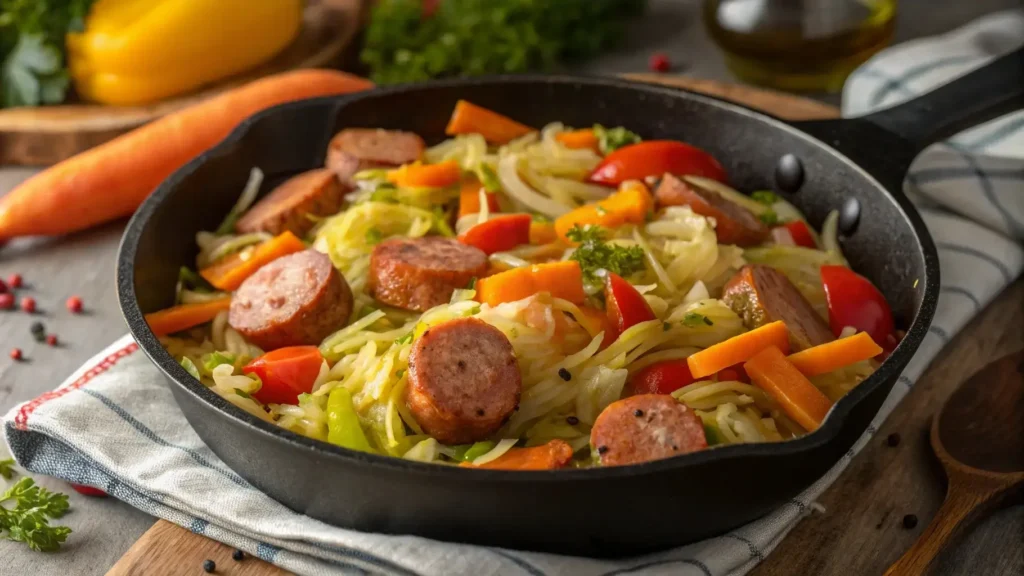
Step 1: Brown the Sausage
Start by heating a large skillet and browning the sausage until crispy and golden brown. This step not only enhances the sausage’s flavor but also creates flavorful drippings in the pan, which you’ll use for the vegetables.
Step 2: Sauté the Aromatics and Vegetables
Remove the sausage and add onions, garlic, and any additional vegetables like carrots or bell peppers. Stir frequently until the onions are translucent and fragrant. Then, gradually add the cabbage, allowing it to wilt and absorb the flavors from the pan.
Step 3: Deglaze and Simmer
Pour in a splash of broth or white wine to deglaze the pan and lift any browned bits stuck at the bottom. This step enhances the dish’s depth. Cover and let everything simmer for about 10 minutes or until the cabbage is tender but not mushy.
Step 4: Combine and Serve
Add the sausage back into the skillet, toss everything together, and let it cook for another 2-3 minutes. Garnish with fresh parsley or a dash of vinegar for added brightness.
Health Benefits of Cabbage and Sausage
Cabbage and sausage isn’t just delicious—it can also be a surprisingly healthy dish when prepared thoughtfully. By balancing protein, fiber, and essential nutrients, you’ll have a satisfying meal that’s as nourishing as it is flavorful.
The Nutritional Power of Cabbage
Cabbage is a low-calorie, high-fiber vegetable that’s loaded with vitamins and antioxidants. It’s particularly rich in vitamins C and K, which support immune health and bone strength. Its fiber content aids digestion, making it a great choice for keeping you full longer. Additionally, cabbage contains antioxidants like polyphenols and sulfur compounds that help reduce inflammation and support heart health.
Protein and Energy from Sausage
Sausage provides protein, which is essential for muscle maintenance and energy. While traditional sausages are often high in fat and sodium, you can make the dish healthier by using lean options like chicken or turkey sausage. Pairing sausage with fiber-rich cabbage creates a balanced meal that sustains energy and keeps cravings in check.
Healthy Add-Ins and Cooking Tips
To further enhance the health benefits, consider adding extra vegetables like carrots, bell peppers, or spinach. Using olive oil instead of butter and reducing the amount of salt can also lighten the dish without sacrificing flavor. Adding herbs and spices like garlic, thyme, and paprika enhances the taste naturally.
By making smart ingredient swaps, you can enjoy cabbage and sausage as a hearty, wholesome meal.
Tips for Perfecting Cabbage and Sausage
For Amateur Cooks
- Choose pre-cooked or smoked sausage: This simplifies the cooking process and reduces prep time.
- Stick to simple seasonings: Salt, pepper, garlic, and paprika are enough to start. Once you’re more comfortable, experiment with additional herbs.
- Use a large skillet or pan: Cabbage reduces in size as it cooks, but it takes up space initially, so give it room to cook evenly.
- Deglaze for extra flavor: Don’t skip the deglazing step. It’s what transforms a good dish into a great one. Use broth, wine, or even water to lift those tasty brown bits.
- Don’t overcook the cabbage: Cook it until just tender for the best texture and taste.
For Advanced Cooks
- Use fresh herbs and spices: Incorporate thyme, rosemary, or caraway seeds for extra depth of flavor.
- Experiment with different sausages: Try Andouille for a Cajun twist or bratwurst for a German-inspired dish.
- Caramelize the cabbage: Cook it on medium-high heat until golden brown before adding the other ingredients to give it a slightly sweet, complex flavor.
- Layer bold flavors: Add vinegar or mustard for a tangy kick, or finish with a drizzle of balsamic glaze for added richness.
- Gourmet toppings: Consider adding crispy bacon bits, grated Parmesan cheese, or toasted breadcrumbs for an elevated texture and flavor.
With these tips, you’ll be able to make cabbage and sausage perfect for any level of cooking experience, whether you’re a beginner or an advanced home cook.
Common Mistakes to Avoid When Cooking Cabbage and Sausage
Even simple dishes like cabbage and sausage can go wrong if you overlook key steps. Here are the most common mistakes and how to fix them:

Overcooking the Cabbage
Overcooked cabbage can become mushy and lose its flavor. To prevent this, cook it just until it’s tender but still has a slight crunch. For recipes that require longer cooking, like braised cabbage, simmer it slowly over low heat to maintain its texture.
Using the Wrong Sausage
Not all sausages are created equal. Using a sausage that’s too bland can result in a flavorless dish, while overly spicy sausage may overpower the cabbage. Smoked or flavorful sausages like kielbasa or Andouille work well because they complement the mildness of cabbage without overwhelming it.
Skipping the Deglazing Step
Deglazing the pan is crucial for enhancing flavor. Those brown bits left after cooking the sausage contain concentrated flavor that can elevate the entire dish. Use broth, wine, or even a splash of vinegar to deglaze and scrape up the goodness.
Neglecting Proper Seasoning
Cabbage can be bland without proper seasoning. Don’t be afraid to use garlic, onions, paprika, and herbs to add layers of flavor. A final squeeze of lemon or splash of vinegar will help balance the richness of the sausage.
By avoiding these mistakes, you’ll consistently create a delicious, well-balanced cabbage and sausage dish every time.
Serving Suggestions and Perfect Pairings for Cabbage and Sausage
Cabbage and sausage is a versatile dish that can be served in many ways, whether as a comforting main course or a flavorful side. The key to enhancing the meal lies in pairing it with complementary sides and drinks.
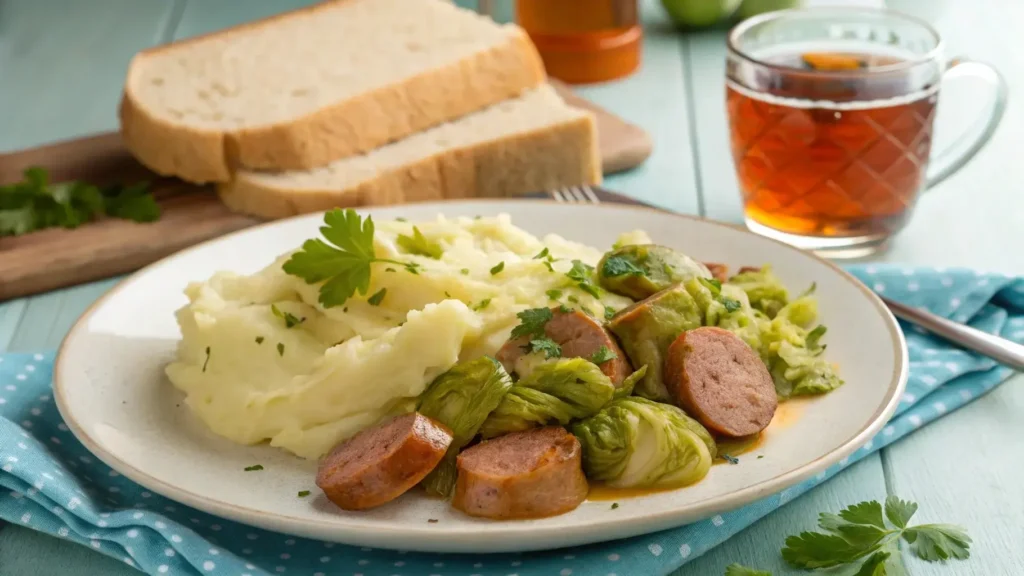
1. As a Hearty Main Dish
Serve cabbage and sausage on its own, garnished with fresh parsley and a squeeze of lemon juice. It’s filling enough to be a standalone meal, but adding a slice of crusty bread or a buttered dinner roll makes it even more satisfying.
2. Pairing with Starchy Sides
Mashed potatoes, rice, and buttered noodles are classic pairings for cabbage and sausage. The starch soaks up the rich juices from the sausage and cabbage, creating a comforting, well-rounded meal. For a twist, try roasted sweet potatoes or baked polenta as alternatives.
3. Complementary Vegetables
A side of roasted carrots, steamed green beans, or sautéed Brussels sprouts pairs well with the dish, adding extra nutrients and color to the plate.
4. Ideal Beverages
Beer is a traditional pairing, especially for German-inspired variations, but cider and dry white wines work just as well. A crisp drink helps cut through the richness of the sausage and enhances the meal’s overall balance.
With these serving suggestions, you’ll have no trouble creating the perfect meal centered around cabbage and sausage.
Storing and Reheating Cabbage and Sausage
One of the best things about cabbage and sausage is that it tastes even better the next day. Proper storage and reheating techniques can help you enjoy this dish for days without losing its flavor or texture.
Storing Leftovers
Allow the dish to cool to room temperature before storing it in an airtight container. Refrigerate for up to 3-4 days. If you plan on keeping it longer, consider freezing it in freezer-safe containers for up to 3 months. When freezing, portion the dish to make reheating easier.
Reheating Tips for Best Flavor
- Stovetop Method: The best way to reheat cabbage and sausage is on the stovetop. Place the leftovers in a skillet over medium heat and add a splash of broth or water to prevent drying out. Stir occasionally until warmed through.
- Microwave Method: If you’re short on time, microwave the leftovers in a microwave-safe dish. Cover it with a damp paper towel to retain moisture and heat in 1-minute intervals, stirring in between.
- Oven Method: For larger portions, preheat the oven to 350°F (175°C) and place the leftovers in an oven-safe dish covered with foil. Bake for 15-20 minutes or until heated through.
By following these storage and reheating tips, you can savor the flavors of cabbage and sausage anytime, whether as a next-day lunch or a ready-to-eat dinner.
Frequently Asked Questions (FAQ)
1. Can I use any type of cabbage for cabbage and sausage?
Yes! Green cabbage is the most common choice due to its mild flavor and ease of cooking, but red cabbage, Napa cabbage, or Savoy cabbage are great alternatives. Red cabbage adds a slightly tangy flavor, while Savoy is more tender and sweet.
2. How do I keep cabbage from getting soggy?
The key is not to overcook it. Sauté the cabbage on medium heat until it’s just tender, but still slightly crunchy. If you’re braising it, cook on low heat and monitor the texture frequently.
3. Can I make cabbage and sausage in a slow cooker?
Yes! Simply brown the sausage first, then add it to the slow cooker with the cabbage and seasonings. Cook on low for 4-6 hours or on high for 2-3 hours until the cabbage is tender.
4. What sausage is best for this dish?
Kielbasa, smoked sausage, or Andouille sausage work wonderfully, depending on your taste preferences. For a leaner option, use chicken or turkey sausage.
The Comfort and Versatility of Cabbage and Sausage
Cabbage and sausage is more than just a simple meal—it’s a comforting, hearty dish that fits any occasion, from a cozy family dinner to a weekend potluck. Its rich, savory flavor, combined with the earthy crunch of cabbage, makes it a go-to comfort food that’s easy to customize and prepare. Whether you prefer it with bold Cajun spices or a traditional German twist, the possibilities are endless.
Beyond its flavor, cabbage and sausage is a practical choice for meal prepping and budget-friendly cooking. With its high protein and fiber content, it keeps you full and energized without needing fancy ingredients or lengthy preparation. We encourage you to experiment with different variations and side dishes to make it your own. Once you’ve mastered the basics, you’ll always have a dependable, delicious meal in your recipe rotation.
